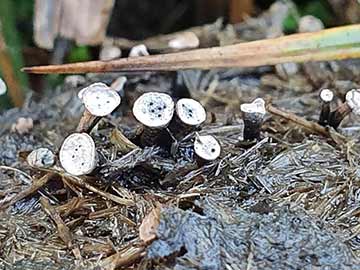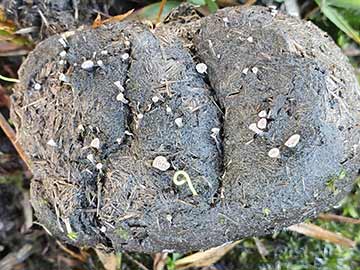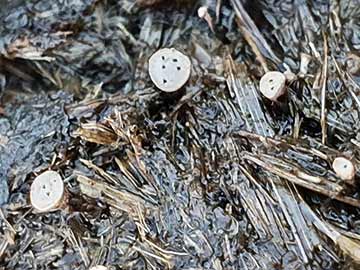Nail Fungus (Poronia punctata)

Any account of New Forest fungi would be incomplete without mention of the Nail Fungus (Poronia punctata) - it's similar to a flat topped, small metal nail, rather than a finger nail.
It's not that the Nail Fungus is conspicuously present, for this is a tiny species that grows on dung and is unlikely to be noticed by casual observers. It has a very short dark brown, almost black, stalk up to 2 centimetres in length, rooted into the dung; topped by a small - no more than 1.5 centimetres across - flattened, buff-white cap dotted with small, dark-coloured pores from which the spores are released.
Significance is more to do with the Nail Fungus' status as a national rarity - the New Forest is its stronghold, whilst elsewhere in the UK and in a European context it is largely absent. In fact, it has been described as 'one of Europe's most threatened fungus species' and was included as 'Endangered' in a 1992 Red Data List and as 'Near Threatened' in a 2006 version. It is also a UK Biodiversity Action Plan species and has been somewhat controversially described in the BAP as 'possibly the rarest fungus in Europe'.
The Nail Fungus is usually considered to be an autumn species although the visible fruiting bodies can persist throughout the winter and into spring - Gordon Dickson and Ann Leonard (Fungi of the New Forest - a Mycota) list sightings in all months of the year with the exception of May, June and July.
The life cycle of the Nail Fungus provides just as much interest as its rarity. In common with other dung loving species, its spores gather on grasses and other vegetation, are swallowed by feeding ponies, passed out with their dung, germinate and eventually produce visible fruiting bodies after the dung has had time to weather.
Not surprisingly taking into account its small size and liking for dung, the Nail Fungus is not considered to be edible.

In the UK it is thought to be exclusively associated with horse and pony dung, although elsewhere in the world it has been reported on cow dung. (UK reports of Nail Fungus on rabbit dung are considered to be linked to a closely related, even scarcer species: Poronia erici).
Widespread presence in the New Forest, then, should not come as too much of a surprise given the generous amounts of dung dropped by commoners' ponies, although in relatively recent years, for the first time or after really long absences, it has also been noted on Thursley Common (Surrey), in Thetford Forest (Norfolk), at Newborough Warren (Anglesey) and at a small number of other UK sites, maybe as a result of the increased use of ponies for conservation grazing.
(Statements made elsewhere suggesting that the UK distribution of this fungus is entirely restricted to the New Forest are therefore misleading).
Its habitat requirements, though, are very specific, for it doesn't occur on any old pony dung. Apparently the dung should be at least a few weeks old and still be in lumps, whilst in the New Forest it's been suggested that the fungus has a particular liking for dung dropped on heathland and to a lesser extent, for dung dropped on open, acidic, unimproved grassland. It is not normally associated at all with dung lying in woodland or on previously limed or otherwise fertilised grassland.
It has not always been nationally rare, however, as until the late 19th century it was said to be 'widespread and not uncommon' throughout much of the country. But subsequent decline was rapid resulting in large scale extinctions outside the New Forest - there were few, if any, formal records of UK presence during the first 70 years of the 20th century.
Various reasons for the decline have been suggested, including: loss of unimproved pastures as a result of agricultural advances and the widespread use of fertilisers, reduced horse populations as mechanisation came to farm and other work, ever increasing tidiness and cleanliness with far less dung being left to lie where it fell, a reduced incidence of the necessary year round grazing on individual sites, changes to horse and pony diets resulting from the increased use of additives in animal feeds, and improvements in veterinary care.

In the New Forest, significant reductions in the number of ponies depastured during the first half of the 20th century may have resulted in severe local declines or the virtual absence of this fungus, although there have been suggestions that it remained present throughout, and in places was relatively abundant, but went unrecorded.
Whatever the case, formal reports of presence within the New Forest have certainly increased since the early / mid-1970s, maybe, at least in part, reflecting a post-1950 growth in the number of ponies put out on the Forest - animals that would, of course, produce more and more fungi-friendly dung.
Or maybe the increases simply reflect greater recording effort. Who knows for sure?
Warning: refer to a good, comprehensive fungus field guide to confirm identification, and only eat those species known without any doubt whatsoever to be edible - people have died after eating certain poisonous specimens.
References:
Mushrooms and other Fungi of Great Britain and Europe - Roger Phillips
Fungi of the New Forest: A Mycota - Edited by Gordon Dickson and Ann Leonard
Biodiversity in the New Forest (Fungi) - Adrian C. Newton
The New Forest, A Natural History - Colin R. Tubbs
Coprophilous fungi (dung-loving fungi)
National Biodiversity Network Atlas
Royal Botanic Gardens - Kew
First Nature - Poronia punctata, Nail Fungus
More links
Other related links
Search this site

Sadly, 58 animals were killed - 35 ponies, 13 cows, 8 donkeys and 2 sheep, whilst a further 32 were injured - 3 pigs, 9 donkeys, 11 cows and 9 ponies.
(Forty-three accidents occurred in daylight, 15 at twilight and 101 in the dark. Twenty-seven accidents were not reported by the driver involved).
Here's just one horrific example - Three donkeys killed in collision with van at notorious New Forest blackspot (Advertiser and Times)

